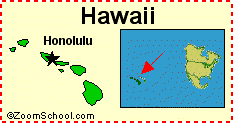The 1778 arrival of British explorer James Cook was Hawaii’s first documented contact with European explorers. Cook named the islands the “Sandwich Islands” in honor of his sponsor John Montagu, 4th Earl of Sandwich.
After Cook’s visit and the publication of several books relating his voyages, the Hawaiian islands received many European visitors, bearing somewhat dubious gifts: by 1820, Eurasian diseases, famine, and wars among the chiefs killed more than half of the native Hawaiian population. During the 1850s, measles killed a fifth of Hawaii’s remaining people. Moreover, missionaries flowed into the islands, intent on converting many Hawaiians to Christianity.
Hawaii became a key provisioning spot for American whaling ships and a new source of sugar cane production. But leaders in Washington were concerned that Hawaii might become part of a European nation’s empire. During the 1830s, Britain and France compelled Hawaii to accept treaties giving their own countries economic privileges.
In 1887, the king was coerced into signing the 1887 Constitution of the Kingdom of Hawaii, which stripped him of much of his authority. The constitution also instituted income and wealth requirements for voting, disenfranchising most Hawaiians and immigrant laborers, and favoring the wealthier white community. Because the 1887 Constitution was signed under threat of violence, it is known as the “Bayonet Constitution”. King Kalākaua, reduced to a figurehead, reigned until his death in 1891. His sister, Liliʻuokalani, succeeded him on the throne.
In 1893, Queen Liliʻuokalani announced plans for a new constitution restoring rights to Hawaiians. This of course was unacceptable. On January 14, 1893, a group of mostly Euro-American business leaders and residents formed a Committee of Safety to overthrow the Kingdom and seek annexation by the United States. The U.S. Government Minister, responding to a request from the Committee of Safety, summoned a company of U.S. Marines. As one historian noted, the presence of these troops effectively made it impossible for the monarchy to protect itself.
On January 17, Queen Liliʻuokalani was overthrown and replaced by a Provisional Government composed of members of the Committee of Safety. Sanford B. Dole was named president of the Provisional Government of Hawaii that was formed after the coup.
Controversy filled the following years as the queen tried to re-establish her throne. The administration of President Grover Cleveland requested an investigation by the U.S. House of Representatives Foreign Relations Committee, and the subsequent 1893 “Blount Report” provided evidence that officially identified the United States’ complicity in “the lawless overthrow of the lawful, peaceful government of Hawaii.”
The Blount Report however was followed in 1894 by the Morgan Report. This report concluded that the overthrow was locally based, motivated by a history of corruption of the monarchy, and that American troops only served to protect American property and citizens and had no role in the end of the Hawaiian monarchy.
After William McKinley won the presidential election in 1896, Hawaii’s annexation to the U.S. was again discussed. The previous president, Grover Cleveland, was a friend of Queen Liliʻuokalani, unlike the new president. McKinley was open to persuasion by U.S. expansionists and by annexationists from Hawaii. After negotiations, in June 1897, Secretary of State John Sherman agreed to a treaty of annexation. It was signed in 1898 by President McKinley, but it failed in the Senate.
Instead, the Newlands Resolution was used to annex the Republic to the United States. This was a joint resolution written by and named after United States Congressman Francis G. Newlands. It was an Act of Congress to annex the Republic of Hawaii and create the Territory of Hawaii.
The Newlands Resolution established a five-member commission to report to Congress on which laws were needed in Hawaii. The commission included: Territorial Governor Sanford B. Dole (R-Hawaii Territory), Senators Shelby M. Cullom (R-IL) and John T. Morgan (D-AL), Representative Robert R. Hitt (R-IL), and former Hawaii Chief Justice and later Territorial Governor Walter F. Frear (R-Hawaii Territory).
President William McKinley appointed Dole to become the first territorial governor after U.S. annexation of Hawaii, and Dole assumed the office on June 14, 1900. He resigned however in November, 1903 to accept an appointment by Theodore Roosevelt as judge for the U.S. District Court, serving in that post until December 16, 1915.
In the 1950s the power of the plantation owners was finally broken by descendants of immigrant laborers. Because they were born in a U.S. territory, they were legal U.S. citizens. The Hawaii Republican Party, strongly supported by plantation owners, was voted out of office. Eager to gain full voting rights, Hawaii’s residents actively campaigned for statehood.
In March 1959, Congress passed the Hawaii Admission Act and U.S. President Dwight D. Eisenhower signed it into law. Hawaii joined the Union on August 21, 1959, and is the only U.S. state made up entirely of islands.
In 1993, a joint Apology Resolution (Public Law 103-150) regarding the takeover was passed by Congress and signed by President Clinton. It issued:
. . . .apologizes to Native Hawaiians on behalf of the people of the United States for the overthrow of the Kingdom of Hawaii on January 17, 1893 with the participation of agents and citizens of the United States, and the deprivation of the rights of Native Hawaiians to self-determination…”









No Treaty of Annexation the Hawaiian Kingdom is occupied illegally by the U.S. a joint resolution lacks jurisdiction to acquire another nation.